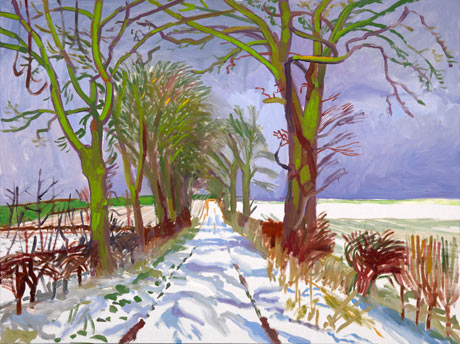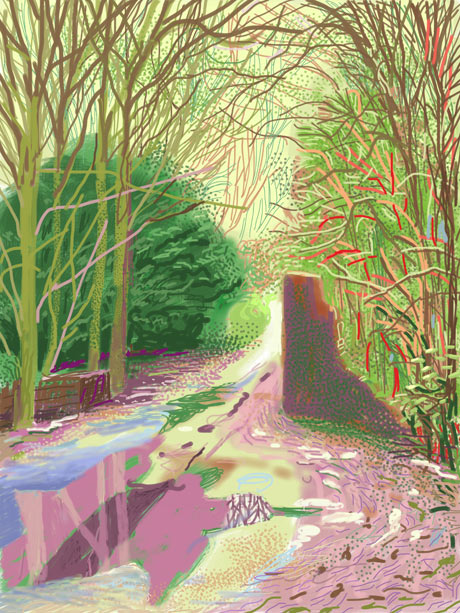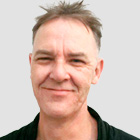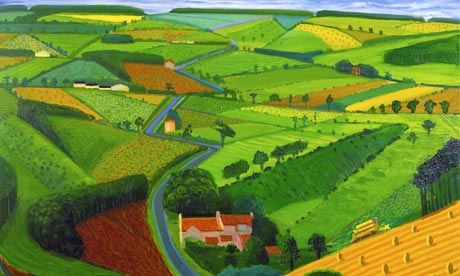The Royal Academy's major show of David Hockney landscapes has its crazy moments. But all that fresh air wears Adrian Searle out
Out in all weathers (rain excepted), standing in woodlands and at roadsides, David Hockney has come a long way from the California poolside, and from the Bradford of his youth – to the east Yorkshire landscape inland from Bridlington, where he now lives for most of the year. Setting up his easels in the great outdoors, or sitting in his car recording his observations with a painting app on his iPhone or iPad, or cruising quiet lanes in a van bedecked with video cameras, Hockney's reinvention of himself as a full-blooded landscape artist is not without danger. As well as nature and the weather, he's up against history.
Hockney's homecoming is recorded in A Bigger Picture, opening this Saturday at the Royal Academy in London. It is a very big exhibition. It goes on and on. It is hard to like Hockney's later work in its entirety, but then you do have to be selective when faced with any facet of his long career. Those funny, sassy, sexy 1960s paintings – caught happily between figuration, storytelling, jokiness and abstraction – are winning in all sorts of ways, as are his pools, his lawn-sprinklered buffed California, his boys in the shower and on their sun-loungers.
Hockney's strengths are mostly graphic and illustrational. He can draw like Ingres (or redo Picasso redoing Ingres) and make of it something of his own. His later landscapes lack the charm, but carry the vices as well as the wit that gave his earlier work such character. They're just big and wilful. Hockney lacks the elan and notational elegance of, say, America'sAlex Katz, as well as the vision of Samuel Palmer and the wonderment ofStanley Spencer, never mind the degree of perspicacity shown by dozens (if not hundreds) of lesser-known landscape artists, many of whom line the walls of the Royal Academy summer shows. And we haven't even got to the very great painters of nature: Courbet andTurner, Monet and Constable, Cézanne and Van Gogh.
The best landscapes here, depicting hawthorns in full spring flower, their branches heavy with blossom, do attain an almost surreal and visionary delight, but they culminate in a painting so over the top – May Blossom on the Roman Road, from 2009 – that it looks as though giant caterpillars were climbing all over a kind of mad topiary, beneath a roaring Van Goghish sky. I wish more works could be as crazy as this: Hockney captures and amplifies something of the astonishment of hawthorns in bloom. I kept thinking of dying Dennis Potter describing inthat 1994 interview with Melvyn Bragg how "nowness" had become so vivid: "Instead of saying, 'Oh, that's nice blossom' … I see it is the whitest, frothiest, blossomest blossom."
This kind of presentness, and sense of presence, is, I think, what Hockney would like to capture. He has always been good at finding surprising and elegant ways to orchestrate differences: the palm tree against the sky, the light on the water, the splash in the still pool. These allow your eye to alight on things in different ways, just as the mind records what the eye sees with various degrees of nuance and recognition. Hockney still tries to do this but fails as often as he succeeds. Looking closely at his paintings of tunnels of trees overhanging a country track, I just get irritated by all the dibbling and dabbing, all that poking and flicking, the results of his attempts to vary the pace and the touch. What he actually lacks is touch itself. I don't mind the coarseness of his smaller and larger painterly gestures, but they seem as affected as they are impetuous. It all becomes a sort of slurry. Large or small, in watercolour or in oils, the paintings seem to sag, their variety – bright celandines under a canopy of spring foliage, a carpet of fallen beech leaves tiger-striped by shadow – becoming a sort of sameness.
Often, his painterly effects work well enough in reproduction. Looking at the catalogue I get the point, but in the raw, the paintings aren't nearly so successful. They don't bear looking at for very long. And there are other artists, whose ambitions aren't nearly so developed as Hockney's, who do this sort of thing much better. I think he is fighting slickness, or too much style, or rote solutions to painting problems: how to do bare branches, puddles on the path, the grass under your feet, the herringbone rhythms of tractor tracks. It is clear Hockney is excited by these variations and difficulties. But all those splodges and patterns, smears and dapples and churnings get very wearying. I just can't wait to get indoors and kick the gumboots off.
A Bigger Picture opens with a group of large paintings depicting three big trees near Thixendale, painted from the same vantage point in different seasons. Leaves come and go, crops grow, the autumn fields are tilled. Green hills turn blue in winter, under milky skies. We've seen this sort of thing many times.
 David Hockney's Winter Tunnel with Snow, March, 2006, oil on canvas. Photograph: Richard Schmidt
David Hockney's Winter Tunnel with Snow, March, 2006, oil on canvas. Photograph: Richard SchmidtIn the catalogue, Margaret Drabble drivels on about Hockney's homecoming. "He eschews the misty elegiac pastoral mode," she says. But it is precisely this mode, updated, that gives Hockney's later work its charm, such as it is. Hockney, Drabble tells us, "has not founded a Bridlington school". But he runs very close to a school of mucky, chancy English landscape painting that is already ubiquitous – and degraded by its overfamiliarity.
The show takes a detour through earlier Hockney landscapes: from mid-1950s student work depicting a dreary Bradford suburb, to a huge 1998 painting of the Grand Canyon. Along the way there are witty photocollages, including 1986's Pearblossom Highway, a desert road littered with signage and beer bottles, and a full-size photographic reproduction of his 1980 painting Mulholland Drive: The Road to the Studio. It is extremely unpleasant to go from real paintings, with their record of touches and accretions, to this gigantic reproduction. There are things the photograph can't record. This is the work of art in the age of electronic reproduction – and it is just a precursor to what comes later.
 iPad drawing No 2 from David Hockney's The Arrival of Spring in Woldgate, East Yorkshire 2011
iPad drawing No 2 from David Hockney's The Arrival of Spring in Woldgate, East Yorkshire 2011The largest gallery is filled with a single work in many parts: The Arrival of Spring in Woldgate, East Yorkshire in 2011 (twenty-eleven). The piece is as cumbersome as its title, which is printed on the wall above a giant multi-panelled painting. The other walls are double-hung with blown-up, printed images of drawings made on an iPad. Hockney uses the app again, in works depicting Yosemite in the American west. It allows him to draw like Van Gogh, to blur and smear and dapple and dot, to do all the things painting can do, except paint. The images have no texture, surface or sheen. They look almost wipable. They can never hide their electronic origins, no matter how painterly they appear. There's something inescapably dead and bland and gutless about them.
Hockney mistakes, I think, technology for modernity. He has worked with older technologies: the Polaroid, the colour photocopier, the fax. Lately, he has even been making multi-panelled digital videos, shot while driving along the same roads he paints. The camera doesn't linger and neither should we. Openness to technical innovation is one thing, art another. All you are left with is spectacle. The video featuring dancers in the artist's studio, hoofing, tap-dancing and generally enjoying themselves adds nothing either. These flashy films and iPad drawings feel like filler. Hockney's best landscapes carry a sense of real presence, of being there.



2 comentários:
O BOM MESMO É PODER SEMPRE VER COISAS NOVAS NO GABINETE DE CURIOSIDADES, GOSTEI MUITO DAS IMAGENS, OBRIGADA REGINA, OU MARIA, OU MARIA REGINA, TODAS A MESMA ALEGRE E GENTIL PESSOA COM SEUS CODNOMES.
obrigada, Ivone! eu adoro o David Hockney.
beijos e até breve na nossa expo ;)
Postar um comentário